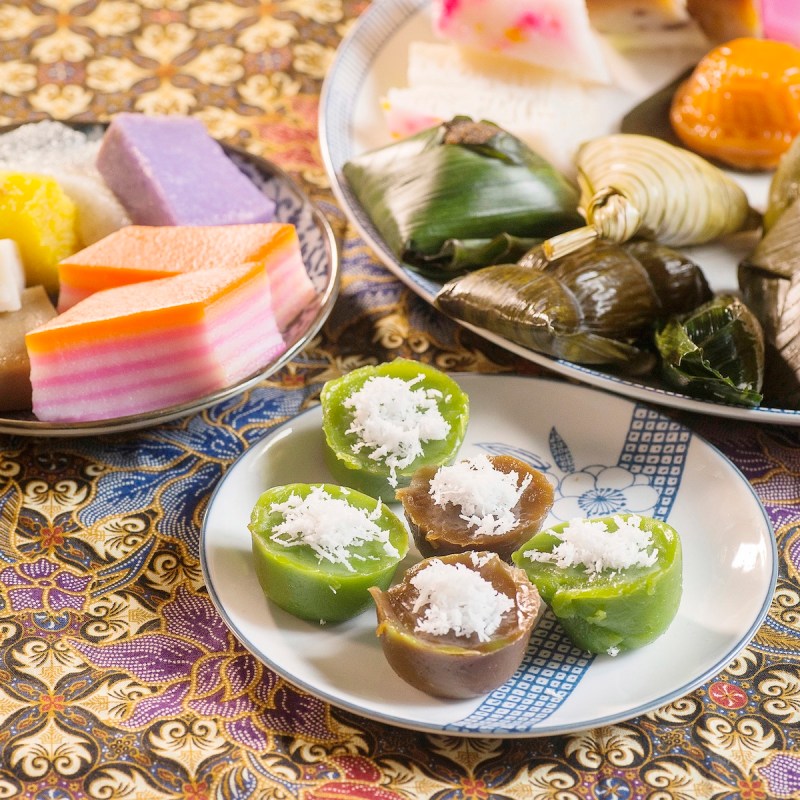
There is a rich multicultural heritage in Penang, with a jumble of Chinese, Indian, Malay, and other cultures. That’s why this tropical island state in northwestern Malaysia, across from southern Thailand, has some of the best street food in Southeast Asia.
Videos by TravelAwaits
The late Anthony Bourdain said of Penang, “It’s the condiments here, the chilis. Once you have that, there’s no going back.” My love of spicy food led me to take a cooking class at Nazlina Spice Station in Penang’s capital of George Town — a UNESCO World Heritage Site packed with colorful shophouses, Chinese and Hindu temples, mosques, and a mansion in this former British colony.
Here are eight classic foods of Penang and where to eat them in George Town.

1. Laksa
Jawi House
Asam laksa, a signature dish of Penang, is spicy, sweet, and sour all at once. It is a fantastic fish soup with rice noodles, tamarind, mint, pineapple, onions, chile paste, and torch ginger flower buds. It’s no wonder CNN Travel named it one of the world’s 50 best foods.
I particularly loved the laksa at Jawi House, which features tuna, mackerel, and a heap of raw greens. Here, it’s called laksa lemak because it uses coconut milk. This restaurant blends Malay, Indian, Pakistani, Arab, and Levant flavors from a sixth-generation family in Penang. It’s located in a charming heritage house on Armenian Street, a street of shops named for an early Armenian immigrant community that included the family behind two famous hotels: Raffles in Singapore and the Eastern & Oriental in Penang.
But every state in Malaysia has its own regional twist on laksa; shrimp is added in Sarawak, while eels and spicy shredded coconut are added in Kuala Kedah. Laksa recipes from all 13 Malaysian states are in the book The Fierce Aunty’s No-nonsense Guide to The Perfect Laksa by Nazlina Hussin — owner of the Nazlina Spice Station.

2. Char Kway Teow
Siam Road Charcoal Char Kuey Teow
A stir-fry of shrimp, flat rice noodles, bean sprouts, eggs, soy sauce, and chile paste, char kway teow is the most iconic street food in Penang. Immigrants from southern China’s Guangdong and Fujian provinces brought their noodle dish (char kway teow means “stir-fry rice cake strips” in Hokkien Chinese) in the 19th century. However, in Penang, pork is substituted for seafood. You’ll find it in most hawker centers and coffee shops, and locals love to debate their favorites.
One of the most popular, hands-down, is this casual stall on Siam Road at the corner of Anson Road. Here, the dish, which also includes Chinese sausage and cockles, is cooked in a wok over a charcoal fire, which imparts a highly prized smoky flavor and aroma. The 80-something owner, who’s cooked this single dish for over 60 years, operated from a bike pushcart for decades until opening this stall a few years ago. It’s one of two Penang eateries named one of the world’s top 50 street food eateries by the World Street Food Congress in 2017.
Pro Tip: Expect to stand in line for an hour or more (many customers order several), unless you go during off-hours. It’s near a hawker center, New World Park Food City, where I also ate an excellent char kway teow, minus the long wait.

3. Curry Tumis
Auntie Gaik Lean’s Old School Eatery
This spicy and sour fish curry — made with tamarind, galangal, lemongrass, and ginger served with lady’s fingers — is one of the gems of Nyonya cuisine, unique to Malaysia. Nyonya is the word for Peranakan women of mixed Malay-Chinese ancestry who have their own food, crafts, and traditions. The men are called babas.
The curry tumis is superb at Auntie Gaik Lean’s Old School Eatery — a Nyonya restaurant called the world’s cheapest Michelin-starred eatery and one of two Michelin-starred restaurants in Penang. Beh Gaik Lean and her staff follow the perfectionist standards she learned as a fourth-generation Nyonya.
In an old-fashioned setting amid flowery wallpaper, patterned floors, vintage equipment in the window — plus vintage music (I heard 1958’s “It’s All in the Game”) — Auntie Gaik Lean’s is open for lunch and dinner.
Pro Tip: Order fresh nutmeg juice to wash it down, and, for dessert, tapioca pearls with coconut milk and brown palm sugar — sago gula melaka.

4. Nasi Kandar
Restoran Nasi Kandar Line Clear
An Indian-Muslim dish, nasi kandar is steamed rice with a meat or fish curry in a spicy, rich gravy flavored with aniseed. The meat is beef, lamb, or chicken, but never pork due to Muslim dietary laws. It’s named for the 7-foot-long poles street vendors once carried on their shoulders with dangling pots of rice and curry to dock workers for lunch (nasi kandar translates to “shoulder rice”).
A casual, loud stall tucked in an alley on Penang Road at the corner of Chulia Street, Line Clear (the local term means “no problem”) serves fantastic nasi kandar in generous portions and at cheap prices. It’s very popular among locals, so lines are long. Come early or late for lunch or dinner (it’s open 24 hours). Line Clear was placed on the World Street Food Congress’s list of the world’s top street food eateries at #9. Anthony Bourdain enjoyed his visit here in No Reservations Season 8.

5. Nasi Lemak
Ali Nasi Lemak Daun Pisang
The national dish of Malaysia, nasi lemak is steamed rice in coconut milk (lemak means coconut). It’s generally served with sambal, a spicy chile pepper and shrimp paste; dried anchovies in a spicy paste of chiles, tamarind, shrimp paste, cashews, and peanuts; fried peanuts; fried chicken; or beef rendang. It’s a favorite breakfast dish in Malaysia as well. (Even Malaysia Airlines serves it.)
Ali Nasi Lemak is a hawker stall in the Sri Weld Food Court on Beach Street in the financial district. It draws crowds for what many call the best nasi lemak in George Town: a mound of rice drenched in a fiery sambal wrapped in a banana leaf with a choice of toppings like anchovies with hard-boiled egg, chicken, shrimp, fish, or squid.

6. Cucur Udang
Penang Famous Chowrasta Cucur Udang
Crispy deep-fried shrimp fritters filled with bean sprouts served with a peanut or chile dipping sauce: That’s cucur udang. Two fat shrimp fritters and a tofu cube — with a sweet-tart sauce of dates, tamarind, sweet potato, and sugar — are under a dollar at this stall by the Chowrasta Market on George Town’s Penang Road. The owner has run the stall for over 40 years; the sauce has been a family recipe for generations. The Chowrasta Market also sells meat, produce, souvenirs, and clothing.

7. Kuih
Moh Teng Pheow Nyonya Koay
These tiny colorful sweets made of rice or tapioca flour, coconut milk, and palm sugar, come in dozens of varieties in Penang. Sold at day and night markets, kuih was also a daiy guest-room amenity in my hotel, The Blue Mansion — the exquisitely ornate, cobalt-blue former home of a wealthy Chinese merchant. The blue, yellow-orange, red, and green colors and different flavors come from ingredients like butterfly pea flower, pumpkin, beetroot juice, and pandan leaves. A cube striped in layers of rainbow colors is called kuih lapis.
Family-owned Moh Teng Pheow, one of the largest kuih-makers in Penang, opened in 1933 in a salmon-colored building at the end of Masjid Road off Chulia Street. My favorite was the kuih flavored with coconut and pandan.

8. Mee Goreng Mamak
Bangkok Lane Mee Goreng
Mee goreng mamak is a stir-fry of noodles with tofu, eggs, potatoes, and bean sprouts in a red gravy made of soy sauce, chile paste, and ketchup in a wok. It can have add-ons like squid with a slice of lime, meat, or vegetables only. Most Indian-Muslim (Mamak) restaurants and stalls serve the dish, whose name simply means “fried noodles.”
This casual family-owned stall, since it began almost 80 years ago, is now in the New World Park Food City hawker center on Burma Road after moving from a coffee shop on Bangkok Lane.
